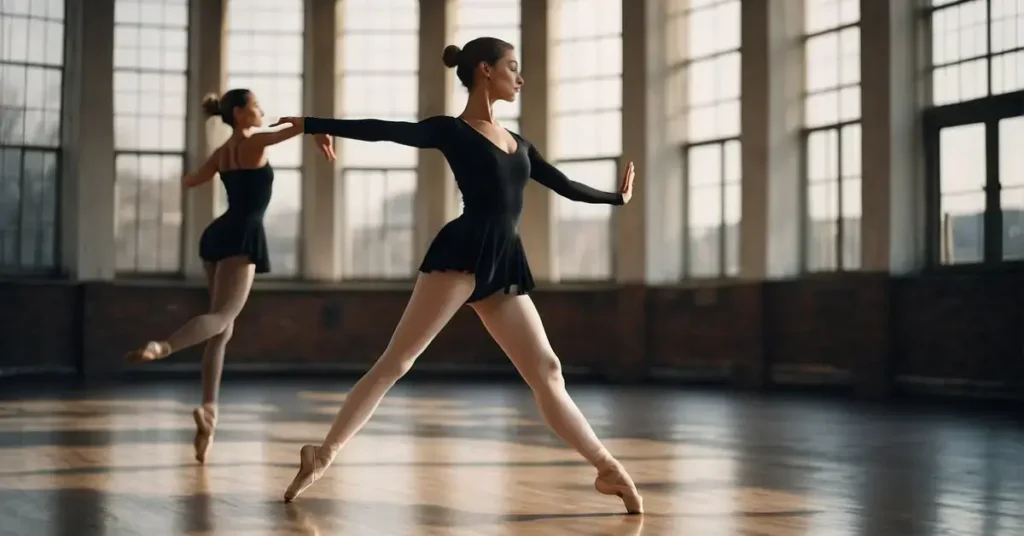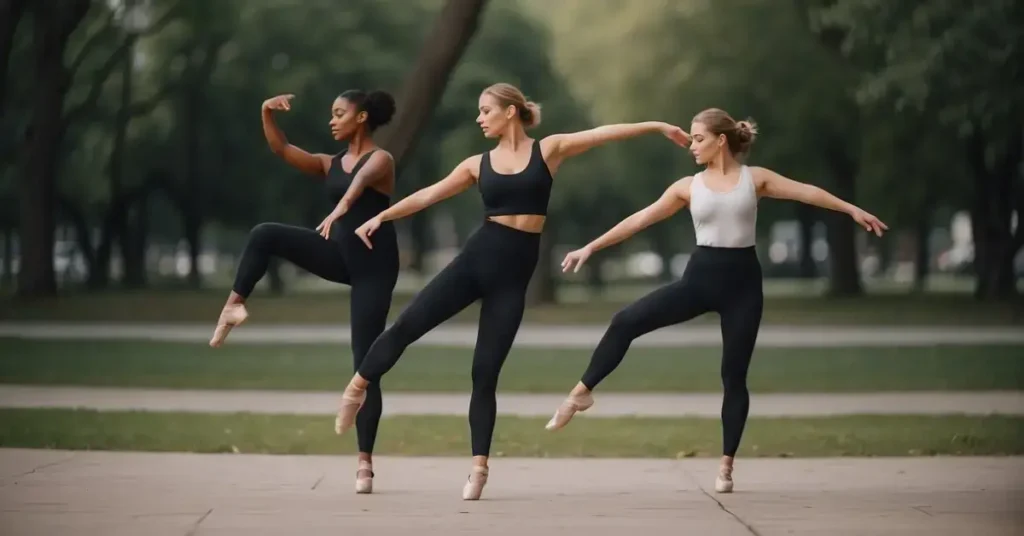Step into the limelight with poise as we explore the world of ballet poses, your guide to mastering elegance and grace in dance in 2024. Perfect your artistry and technique with our detailed breakdown of timeless positions that are the foundation of ballet’s beauty.
Basics of Ballet Positions

We’re excited to guide you through the fundamentals of ballet poses, where the elegance of movement begins with mastering the foundational positions of the feet and arms. Let’s dive into the crucial stances every aspiring dancer needs to know!
The Five Basic Feet Positions
- First Position: Feet are turned out completely with heels touching.
- Second Position: Feet are separated by a distance roughly the width of your own foot, turned out.
- Third Position: Heel of one foot is placed near the arch of the second foot, with feet turnout.
- Fourth Position: One foot is placed approximately twelve inches in front of the other, turned out.
- Fifth Position: Feet are turned out with the heel of one foot touching the toes of the other.
Each of these positions forms the fundamental structure for executing ballet moves, integral for every ballet dancer to practice meticulously.
Positions of the Arms
- First Position: Arms are gently rounded with palms facing inwards towards each other.
- Second Position: Arms are extended to the sides with a slight bend at the elbow.
- Third Position: One arm is rounded above the head while other arm remains in second position.
- Fourth Position: One arm is rounded overhead, the other out to the side or in front.
- Fifth Position: Arms are rounded overhead with fingers nearly touching.
These arm positions beautifully frame the dancer’s body and complement the feet positions, creating harmonious ballet poses.
Core Ballet Moves
- Plie (Bended): A knee bend executed in either first, second, fourth, or fifth position.
- Tendu (Stretched): The leg extends along the floor until only the pointe or demi-pointe is touching.
- Pirouette (Turned): A complete turn on one foot, either on pointe or demi-pointe, typically initiated from fourth or fifth position.
Understanding these elementary moves is essential, as they are the building blocks of more complex and graceful ballet choreography.
Fundamental Ballet Techniques
Exploring ballet poses opens up a world of grace and precision that’s at the heart of this magnificent art form. We’ll focus on the technical skills that form the cornerstone of every dancer’s journey.
Turn-Out and Alignment
The foundation of classical ballet is the concept of turn-out, where the legs are rotated outward from the hip joint—a technique crucial for creating beautiful lines and allowing for greater range of movement. Proper alignment is also essential, ensuring that the body is correctly positioned from head to toe to avoid injury and increase stability. The Pittsburgh Ballet Theatre provides insights into how these principles apply to the basic positions.
Plié and Relevé
The terms plié (bending of the knees) and relevé (rising to the balls of the feet) are foundational movements that serve as building blocks for more complex sequences.
- A plié can be done in multiple positions, each with a distinct purpose:
- Demi-plié: a small bend used as preparation for jumps
- Grand plié: a deeper bend where the heels lift off the ground (except in second position)
- A relevé involves elevating the heels and can be executed:
- With a spring from flat feet to the toes
- By rolling through the foot to reach full pointe
Barre Work for Beginners
For beginners learning ballet poses, barre work is the first real taste of what ballet class is like. Picture a series of exercises performed using the barre as a support. These movements are designed to warm up the muscles and improve balance, strength, and flexibility. Starting with bras bas (arms low), dancers develop control and coordination that’s essential for the progression in ballet. Practicing at the barre allows dancers to focus intensely on their technique and turnout without the added challenge of maintaining balance at the center.
Artistry in Ballet
When we explore ballet poses, we’re not just talking about the physical shapes dancers create; it’s about the artistry woven through each motion, making the movement speak.
Graceful Movements and Lines
Achieving grace in ballet is about more than just good form; it’s the elegance with which we carry our bodies through every pose. Each line is a brushstroke in our larger canvas, from the pointed arch of a foot to the elongated stretch of a leg.
It’s this dedication to graceful movements that transforms our technique into a living art form, demonstrating the flowing and lyrical quality that is so intrinsic to ballet. Consider the Arabesque as an example—though technically demanding, it embodies the essence of grace with its poised and extended shapes.
Incorporating Expression and Port de Bras
Ballet isn’t just physical; it’s emotional. The port de bras—or carriage of the arms—is our tool to convey the character’s inner landscape with fluidity and ease. It’s how we invite our audience into the story. Ballet poses are infused with expression when we integrate port de bras, so our movements become a means to communicate, not just sequences to accomplish.
The subtle gestures, the rise and fall of our arms, all contribute to a deeper artistry within the discipline.
Advanced Ballet Techniques and Movements

Ballet poses form the essence of our performance, embodying grace and technical prowess. As we explore advanced techniques, the intricate movements challenge even the most skilled dancers, pushing us towards the peak of our artistic expression.
Mastering the Pirouette
The pirouette is a staple in advanced ballet repertoire. It is a controlled turn on one leg that begins and ends with a pose such as passé. A successful pirouette requires a combination of strength, balance, and focusing on a fixed point (spotting). To master this move, a ballet dancer must:
- Develop a strong core and leg muscles.
- Practice balancing in relevé (on the balls of the feet) and retiré (foot placed at the knee of the standing leg).
- Ensure precise arm positions and work on the coordination with the turning motion.
Adagio and Pas de Deux
Adagio refers to slow, flowing movements that emphasize line and extension, often seen in a pas de deux, which is a dance for two. This dance highlights the relationship and emotional connection between the dancers, with moves displaying balance, control, and grace. Key components involve:
- Complex lifts, where the strength of the male dancer supports the poise of the professional ballerina.
- Coordinated choreography where dancers mirror or complement each other’s movements.
- Communication and trust between partners, essential for seamless transitions and lifts.
The adagio sequences in pas de deux showcase a ballet dancer’s ability to convey emotion through extended, sustained movements that seem almost ethereal. A skilled choreographer intricately designs these pieces to highlight the dancers’ profound technical ability and deep expressiveness, making these ballet poses truly mesmerizing to watch.
Ballet Training and Performance
Embarking on the journey to master ballet poses calls for dedication, finesse, and an unwavering commitment. We understand the intricate blend of art and athleticism that’s essential during training and performances.
Tips for Improving Ballet Technique
Consistent Practice: The key to excelling in ballet class is regular, focused practice. Incorporating daily exercises that emphasize ballet positions such as arabesque, attitude, and a la seconde can significantly enhance your technique.
- Strength Training: Integrating exercises like Pilates can bolster the muscles used in ballet, supporting the technical precision necessary for moves en pointe.
- Flexibility: Stretching before and after class helps maintain the flexibility required for an extensive range of motion in different poses.
- Professional Feedback: Seek consistent input from instructors to improve your form, particularly for complex techniques like croisé and balancing en pointe.
Joining a Ballet Company
Auditions: To join a dance company, one must stand out in auditions. Polish your presentation of ballet moves and ensure your pointe shoes are in excellent condition to showcase clean, precise footwork.
- Develop a Repertoire: Be prepared to display a versatile range of ballet poses, from the subtle nuances of corps de ballet to the dramatic spotlight of a solo ballerina.
- Performance Experience: Gaining experience through recitals or competitions can not only increase your exposure to various stages and types of light but also boost your confidence significantly.
By implementing these strategies, we can work towards transforming our passion for ballet into a thriving career within a reputable ballet company.
Our favorite ballet poses

Growing up, I was mesmerized by the serene beauty of ballet, and through years of practice, I discovered the joy and challenge of perfecting various ballet poses. The arabesque always felt like capturing a moment of pure poetry in motion, with every muscle telling a story of reach and aspiration.
The disciplined elegance of the pirouette, a whirlwind of focus and grace, taught me the art of balance and the thrill of dizzying spins. But it was the fluidity and expressive power of the port de bras that truly spoke to me, allowing the music to flow through the arms and into the heart. These ballet poses became more than just movements; they were expressions of an inner dance that continues to resonate with me.
FAQ – Ballet Poses
What are the 5 poses of ballet?
The five basic positions in ballet are first, second, third, fourth, and fifth position.
What is the hardest ballerina pose?
One of the hardest ballerina poses is the “en pointe” on one leg, particularly in a “fouetté turn” or “arabesque penchée.”
Are there 7 positions in ballet?
In classical ballet, there are traditionally five positions of the feet, not seven.
What are your most favorite ballet poses? Let us know in the comments!

